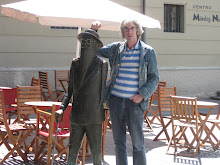
I attended my first ever roller hockey match yesterday. The match was a Spanish top of the table clash in La Coruña. The visitors handed Liceo their first defeat of the season with a surprisingly comfortable win. Obviously a newcomer to the sport does not see it through the same eyes as a seasoned fan, but it looked to me as if Egurrola, the Barça goalkeeper (if that's the right term) had an outstanding game, while Liceo spurned too many chances.
Roller hockey is a sport that’s particularly popular in Catalonia. Most of the best teams in the Ok Liga are Catalan and many cities there have their own club. Surprisingly, a little research tells me that Great Britain played a leading role in founding the sport and were once regarded as the best in the world. But since the Second World War they have been very much overtaken by Spain, Portugal and Italy. Roller hockey is also quite popular in South American countries like Argentina and Chile.

A game consists of two halves of 25 minutes. However, the clock stops between plays so the duration is roughly the same as a football match.
Advantages over football? Well, it’s reasonably priced for a start. I paid 7 Euros for my ticket. The cold slab seating may not be up to the standard you expect at top class football these days, but it’s a comfortable indoor environment where you don’t get really cold or wet.
The atmosphere was good with nearly three thousand in the stands and drummers backing their team throughout, while a few “Ultra” fanatics with a megaphone ensured the crowd didn't get too sedate. It was also pleasing to see the home fans accept defeat in a gracious away. Some applauded the victors off the court while the Liceo players were also given praise for their sterling effort – not something I could envisage taking place in the “beautiful game” after a 3-0 home defeat.





